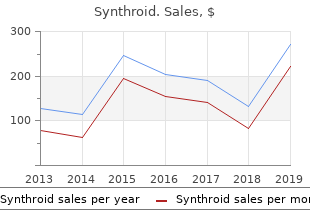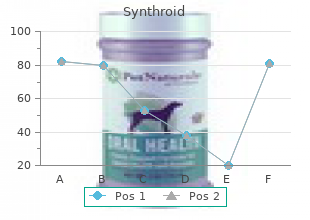Synthroid
"Discount synthroid 125mcg otc, treatment deep vein thrombosis."
By: William A. Weiss, MD, PhD
- Professor, Neurology UCSF Weill Institute for Neurosciences, University of California, San Francisco, San Francisco, CA

https://profiles.ucsf.edu/william.weiss
Balloon catheter dilation of the distal nasolacrimal duct may be useful for patients with 191 partial obstruction but is ineffective in resolving a complete obstruction discount synthroid 50 mcg on line medications vs medicine. Patients with chronic dacryocystitis should undergo lacrimal surgery prior to cheap synthroid 50mcg on line medications keppra elective intraocular surgery to purchase 125 mcg synthroid mastercard symptoms wheat allergy reduce the risk of endophthalmitis order synthroid 25mcg on line symptoms definition. Most cases of canalicular stenosis are acquired and are due to viral infections, usually varicella-zoster, herpes simplex, or adenovirus infection, trauma, conjunctival inflammatory diseases such as Stevens-Johnson syndrome, toxic epidermal necrolysis, erythema multiforme, and ocular cicatricial pemphigoid. Alternatively, it may result from drug therapy, either systemic chemotherapy with fluorouracil or topical idoxuridine. Canaliculitis is an uncommon chronic unilateral infection caused by Actinomyces species, Candida albicans, Aspergillus species, anaerobic streptococci, or staphylococci (Figure 4�16). The patient typically complains of a mildly red and irritated eye with a slight discharge that is often incorrectly diagnosed as conjunctivitis. It affects the lower canaliculus more often than the upper, usually occurs in adults, and causes a secondary conjunctivitis. Clinical Findings 192 Canalicular probing and irrigation aid in identification of the location and severity of obstruction. No regurgitation of material through the puncta will occur if there is complete obstruction of the common canaliculus or of both the upper and lower canaliculi. In canaliculitis, the punctum usually pouts, and pus can be expressed from the canaliculus, with the organism being identifiable by Gram stain and culture. Treatment Partial common canalicular stenosis may be amenable to intubation with a silicone stent for 3�6 months, but severe cases require dacryocystorhinostomy combined with canaliculoplasty and silicone intubation. Total canalicular obstruction necessitates formation of a fistula between the conjunctival sac and the nose (conjunctivo-dacryocystorhinostomy) with insertion of a Pyrex glass (Jones) tube to maintain its patency. For canaliculitis, curettage of dacroliths from the involved canaliculus, followed by irrigation with antibiotic solution, may be effective in establishing patency, with ongoing antibiotic therapy dictated by microbiological results. It varies in severity from a mild hyperemia with tearing to a severe conjunctivitis with copious purulent discharge. Conjunctival inflammation that occurs in the setting of uveitis and scleral or episcleral inflammation are discussed in Chapter 7. Differentiation of the Common Types of Conjunctivitis 201 Because of its location, the conjunctiva is exposed to many microorganisms and other environmental factors. In the tear film, the aqueous component dilutes infectious material, mucus traps debris, and a pumping action of the lids constantly flushes the tears to the tear duct. In addition, the tears contain antimicrobial substances, including lysozyme and antibodies (immunoglobulin [Ig] G and IgA). Common pathogens that can cause conjunctivitis include Streptococcus pneumoniae, Haemophilus influenzae, Staphylococcus aureus, Neisseria meningitidis, most human adenovirus strains, herpes simplex virus type 1 and type 2, and two picornaviruses. Two sexually transmitted agents that cause conjunctivitis are Chlamydia trachomatis and Neisseria gonorrhoeae. Cytology of Conjunctivitis Damage to the conjunctival epithelium by a noxious agent may be followed by epithelial edema, cellular death and exfoliation, epithelial hypertrophy, or granuloma formation. There may also be edema of the conjunctival stroma (chemosis) and hypertrophy of the lymphoid layer of the stroma (follicle formation). Inflammatory cells, including neutrophils, eosinophils, basophils, lymphocytes, and plasma cells, may be seen and often indicate the nature of the damaging agent. These cells migrate from the conjunctival stroma through the epithelium to the surface. They then combine with fibrin and mucus from the goblet cells to form conjunctival exudate, which is responsible for the �mattering� on the lid margins (especially in the morning). The inflammatory cells appear in the exudate or in scrapings taken with a sterile platinum spatula from the anesthetized conjunctival surface. The material is stained with Gram�s stain (to identify the bacterial organisms) and with Giemsa�s stain (to identify the cell types and morphology). Predominance of polymorphonuclear leukocytes is characteristic of bacterial conjunctivitis. If a pseudomembrane or true membrane is present (eg, epidemic keratoconjunctivitis or herpes simplex virus conjunctivitis), neutrophils usually predominate because of coexistent necrosis. In chlamydial conjunctivitis, neutrophils and lymphocytes are generally present in equal numbers. In allergic conjunctivitis, eosinophils and basophils are frequently present in conjunctival biopsies, but they are less common on conjunctival smears; eosinophils or eosinophilic granules are commonly found in vernal keratoconjunctivitis. Symptoms of Conjunctivitis the important symptoms of conjunctivitis include foreign body sensation, scratching or burning sensation, sensation of fullness around the eyes, itching, and photophobia. Signs of Conjunctivitis (Table 5�2) Hyperemia is the most conspicuous clinical sign of acute conjunctivitis. The redness is most marked in the fornix and diminishes toward the limbus by virtue of the dilation of the posterior conjunctival vessels. Hyperemia without cellular infiltration suggests irritation from physical causes, such as wind, sun, smoke, and so on, but it may occur occasionally with diseases associated with vascular instability (eg, acne rosacea). Tearing (epiphora) is often prominent in conjunctivitis, with the tears resulting from the foreign body sensation, the burning or scratching sensation, or the itching. An abnormally scant secretion of tears and an increase in mucous filaments suggest dry eye syndrome. The exudate is flaky and amorphous in bacterial conjunctivitis and stringy in allergic conjunctivitis. Pseudoptosis is a drooping of the upper lid secondary to infiltration and inflammation of Muller�s muscle.
Diseases
- Transitional cell carcinoma
- Laurence Prosser Rocker syndrome
- Albinism
- Talipes equinovarus
- Glycogenosis type VII
- Atrial myxoma
- Cerebellar ataxia areflexia pes cavus optic atrophy
- Mononen Karnes Senac syndrome

Postganglionic Horner�s syndrome may be due to generic 100mcg synthroid with amex medicine gabapentin 300mg capsules carotid artery dissection effective synthroid 200 mcg symptoms synonym, skull base tumors purchase synthroid 25mcg on line medicine wheel, or cluster headache discount 50mcg synthroid with mastercard symptoms 28 weeks pregnant. The localization of central and preganglionic Horner�s syndrome is often apparent from the associated clinical features. Sudden-onset isolated painful Horner�s syndrome, particularly with a recent history of neck trauma or associated with pain in the neck or jaw, necessitates urgent 670 investigation for carotid dissection, which may lead to thrombotic or embolic stroke. Horner�s syndrome associated with chronic facial pain, particularly if associated with fifth, sixth, third, fourth, or second cranial nerve palsy, requires investigation for skull-base tumor. In most cases of isolated congenital Horner�s syndrome, no etiology is identified. Birth trauma is a commonly identified cause, and neuroblastoma is occasionally responsible. Unexplained acquired Horner�s syndrome in infants requires imaging for neuroblastoma. Pharmacologic testing with apraclonidine drops confirms Horner�s syndrome by reversal of the anisocoria, with the affected pupil becoming larger than the normal pupil. Hydroxyamphetamine drops differentiate central and preganglionic from postganglionic lesions, but they are difficult to obtain. Coordination of eye movements requires connections between these ocular motor nuclei, the internuclear pathways. The supranuclear pathways are responsible for generation of the commands necessary for the execution of the appropriate movement, whether it be voluntary or involuntary. Classification & Generation of Eye Movements Eye movements are classified as fast or slow (Table 14�2). The generation of a fast eye movement involves a pulse of increased innervation to move the eye in the required direction and a step increase in tonic innervation to maintain the new position in the orbit by counteracting the viscoelastic forces working to return the eye to the primary position. The step change in tonic innervation is produced by the tonic cells of the neural integrator, so called because it effectively integrates the pulse to produce the step. There is a close relationship between the amplitude of movement and its peak velocity, with larger movements having greater peak velocities. The generation of a slow eye movement involves a maintained increase of tonic innervation of magnitude correlating with the required velocity of movement. Thus, the clinical clues to a supranuclear lesion are a differential effect on horizontal and vertical eye movements or upon saccadic, pursuit, and vestibular eye movements. In diffuse brainstem disease, such features may not be apparent, and differentiation from disease at the neuromuscular junction or within the extraocular muscles on clinical grounds can be difficult. Disease of the internuclear pathways results in a disruption of the conjugacy of eye movements. In infranuclear disease, the pattern of eye movement disturbance reflects the involvement of one or more cranial nerves or their nuclei. There may also be insufficiency or spasm of convergence and/or accommodation and loss of downward fast eye movements. The syndrome results from damage to the dorsal midbrain usually involving the posterior commissure. Pineal tumor, hydrocephalus, midbrain infarct or arteriovenous malformation, and trauma may be responsible. Spasm of the Near Response Spasm of the near response, also known as convergence or accommodative spasm, is usually caused by functional disease, but it may be caused by a midbrain lesion. It is characterized by convergent strabismus with diplopia, miotic pupils, and spasm of accommodation (induced myopia). In functional disease, the features are usually intermittent and provoked by eye movement examination. Cyclopentolate 1%, one drop in each eye twice daily, with reading glasses to compensate for loss of accommodation may be helpful. Convergence Insufficiency Convergence insufficiency is characterized by diplopia for near vision in the absence of any impairment of adduction on monocular testing, with refractive error, particularly presbyopia, also having been excluded. It is caused by functional disease or dysfunction of the supranuclear pathway for convergence in the midbrain. In organic lesions, pupillary miosis may still occur when convergence is attempted, whereas in functional disease, it does not. It contains many pathways connecting nuclei within the brainstem, particularly those concerned with eye movements. The typical manifestation of damage to the medial longitudinal fasciculus is an internuclear ophthalmoplegia, in which conjugate horizontal eye movements are disrupted due to failure of coordination between the sixth nerve nucleus in the pons and the third nerve nucleus in the midbrain. On horizontal eye movements, abduction of each eye is normal, whereas adduction of the eye ipsilateral to the lesion of the brainstem is impaired (ie, there is incoordination of gaze to the contralateral side). In the most severe form, there is complete loss of adduction on horizontal gaze, producing constant diplopia on lateral gaze (Figure 14�12). Convergence is characteristically preserved in internuclear ophthalmoplegia except when the lesion is in the midbrain, when the convergence mechanisms may also be affected. Another feature of internuclear ophthalmoplegia is nystagmus in the abducting eye on attempted horizontal gaze, which is at least in part a result of compensation for the failure of adduction in the other eye. Internuclear ophthalmoplegia may be due to multiple sclerosis (usually in young adults), brainstem infarction (usually in older adults), tumor, arteriovenous malformation, Wernicke�s encephalopathy, and encephalitis. Bilateral internuclear ophthalmoplegia is most commonly due to multiple sclerosis. A horizontal gaze palsy combined with an internuclear ophthalmoplegia, due to a lesion of the sixth nerve nucleus or paramedian pontine reticular formation extending into the ipsilateral medial longitudinal fasciculus, affects all horizontal eye movements in the ipsilateral eye and adduction in the contralateral eye.
Order synthroid 75mcg overnight delivery. HIV Phobia and my Anxiety.

Head and/or neck pain fulfilling criterion C consistently to 25mcg synthroid with visa medicine rash demonstrate supposed trigger points buy synthroid 100 mcg mastercard medications listed alphabetically, B discount synthroid 100 mcg on line medicine used to treat chlamydia. Clinical cheap synthroid 100 mcg online symptoms adhd, electrodiagnostic or radiological evidence and response to treatment varies. In the vast majority of cases, probably, or discontinuation of the visual task headache associated with these disorders refiects common D. However, in order to make any of the diag noses listed below, a causal relationship between the head ache and the psychiatric disorder in question must be Comments: There are a number of supportive cases for established. It has therefore been moved to the Definite biomarkers and clinical proof of headache Appendix pending more formal study. For example, in a child with phoria or heterotropia, if it exists, are likely to seek separation anxiety disorder, headache should be attrib advice from an ophthalmologist. Similarly, in an adult with panic disorder, headache should be attributed nose or paranasal sinuses to the disorder only in those cases where it occurs exclu A11. Any headache fulfilling criterion C in clinical practice to describe associations between B. Clinical, nasal endoscopic and/or imaging evi headache and comorbid psychiatric disorders. Evidence of causation demonstrated by at least two of the following: Diagnostic criteria: 1. Any headache fulfilling criterion C depressants, are efiective against headache disorders even B. Headache occurs exclusively when the patient is headache disorder associated with depression and treated exposed or anticipating exposure to the phobic with a tricyclic antidepressant is, in fact, evidence of cau stimulus sation. Comment: Specific phobias typically last for six months or more, causing clinically significant distress and/or A12. Headache occurs exclusively in the context of actual or threatened separation from home or A. Headache occurs exclusively when the patient is exposed or anticipating exposure to social situations Comment: Separation anxiety disorder is persistent, D. The disorder there is marked fear or anxiety about one or more causes clinically significant distress and/or impairment social situations in which the individual is exposed to in social, academic, occupational and/or other impor possible scrutiny by others. The person fears that he or she will act in a way or show anxiety symptoms that will cause him or A. Recurrent unexpected panic attacks fulfilling embarrassed or rejected) or that will ofiend others. Headache occurs exclusively during panic attacks crying, tantrums, freezing, clinging, shrinking or failure D. Comment: Patients with generalized anxiety disorder present excessive anxiety and worry (apprehensive Comments: Exposure to actual or threatened death, ser expectation) about two (or more) domains of activities ious injury or sexual violation may occur directly by or events. Symptoms may include restlessness or feeling occurred to a close family member or friend; by experi excited, tense or nervous, and muscle tension. This is not true of exposure through preparing for activities or events with possible negative electronic media, television, movies or pictures, unless outcomes, marked procrastination in behaviour or this exposure is work-related. After from a stimulus that would not normally be suficient to migraine or cluster headache, a low-grade non-pulsating have this efiect. If the patient falls asleep during an attack and Attack of headache (or pain): Headache (or pain) (qv) wakes up relieved, duration is until time of awakening. If that builds up, remains at a certain level for minutes, an attack of migraine is successfully relieved by medica hours or days, then wanes until it has resolved completely. The aura typically lasts 20�30 minutes and grey/white/black dots or rings shooting over the precedes the headache (qv). See also: Focal neurological visual field of both eyes when looking at homogeneous symptoms, Premonitory symptoms, Prodrome and bright surfaces such as the blue sky), self-lighting of the Warning symptoms. Episodic: Recurring and remitting in a regular or Chronic: In pain terminology, chronic signifies long irregular pattern of attacks of headache (or pain) (qv) lasting, specifically over a period exceeding three of constant or variable duration. In headache terminology, it retains this mean the term has acquired special meaning in the context of ing for secondary headache disorders (notably those episodic cluster headache, referring to the occurrence of attributed to infection) in which the causative disorder cluster periods (qv) separated by cluster remission per is itself chronic. For primary headache disorders adopted for paroxysmal hemicrania and short-lasting that are more usually episodic (qv), chronic is used unilateral neuralgiform headache attacks. The trigeminal autonomic cephalalgias are Focal neurological symptoms: Symptoms of focal the exception: in these disorders, chronic is not used brain (usually cerebral) disturbance such as occur in until the disorder has been unremitting for more than migraine aura (qv). Fortification spectrum: Angulated, arcuate and grad Close temporal relation: this term describes the rela ually enlarging visual disturbance typical of migrainous tion between an organic disorder and headache. Specific temporal relations may be known for disorders Frequency of attacks: the rate of occurrence of of acute onset where causation is likely, but have often attacks of headache (or pain) (qv) per time period not been studied suficiently. Successful relief of a migraine temporal relation as well as causation are often very attack with medication may be followed by relapse dificult to ascertain. International Headache Society 2018 210 Cephalalgia 38(1) Headache: Pain (qv) located in the head, above the classification committee members and/or controversy orbitomeatal line and/or nuchal ridge. Headache days: Number of days during an observed Nuchal region: Dorsal (posterior) aspect of the upper period of time (commonly one month) afiected by neck, including the region of insertion of neck muscles headache for any part or the whole of the day. It may also be Pericranial muscles: Neck and occipital muscles, scored on a verbal rating scale expressed in terms of muscles of mastication, facial muscles of expression its functional consequence: 0, no pain; 1, mild pain, and speech, and muscles of the inner ear (tensor tym does not interfere with usual activities; 2, moderate pani, stapedius). Persistent: this term, used in the context of certain Neuralgia: Pain (qv) in the distribution(s) of a nerve secondary headaches, describes headache, initially or nerves, presumed to be due to dysfunction or injury acute and caused by another disorder, that fails to of those neural structures. Common usage has implied remit within a specified time interval (usually three a paroxysmal or lancinating (qv) quality, but the term months) after that disorder has resolved. Neuropathic pain: Pain (qv) caused by a lesion or Postdrome: A symptomatic phase, lasting up to 48 disease of the peripheral or central somatosensory ner hours, following the resolution of pain in migraine vous system.
Eternal Flower (Sandy Everlasting). Synthroid.
- Liver disorders, gall bladder disease, fluid retention, bronchitis, asthma, whooping cough, psoriasis, burns, rheumatism, headache, migraine, allergies, stomach upset, and other conditions.
- How does Sandy Everlasting work?
- Dosing considerations for Sandy Everlasting.
- What is Sandy Everlasting?
- Are there safety concerns?
Source: http://www.rxlist.com/script/main/art.asp?articlekey=96511

